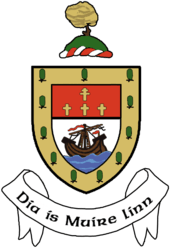Charlestown, County Mayo
| Charlestown Baile Chathail | |
|---|---|
| Town | |
|
| |
 Charlestown Location in Ireland | |
| Coordinates: 53°57′51″N 8°47′39″W / 53.9642°N 8.7942°WCoordinates: 53°57′51″N 8°47′39″W / 53.9642°N 8.7942°W | |
| Country | Ireland |
| Province | Connacht |
| County | County Mayo |
| Elevation | 60 m (200 ft) |
| Population (2011) | |
| • Urban | 914 |
| includes Bellahy, County Sligo | |
| Time zone | WET (UTC+0) |
| • Summer (DST) | IST (WEST) (UTC-1) |
| Irish Grid Reference | G479019 |
Charlestown (Irish: Baile Chathail), once named Newtown-Dillon or Ballycattell, is a town in County Mayo, Ireland. The town is adjoined to Bellaghy, County Sligo. It is located at the crossroads of two National Primary routes, the N17 and the N5. Until the N5 bypass opened in November 2007, traffic congestion was a problem in the town. The busy N17 still passes through the town.
History
Charlestown was built in the middle of the 19th century, on the initiative of Lord Dillon's agent, Charles Strickland, adjoining Bellaghy in County Sligo. Previously, Lord Dillon's Mayo tenants had to take their crops to market in Bellaghy, where they were forced to wait until the Sligo men were finished.[1] The town has now a population of approximately 800 people. The town is well planned with wide open streets and parking facilities. Located on the intersection of two National Primary routes, the N17 and the N5, Charlestown is an ideal stopover or centre to stay and visit other locations.
There are two schools in Charlestown, one primary school, St. Attracta's N.S. and one secondary. St.Josephs Marist Convent. The convent was set up under the Marist order and some remnants still remain as part of the school's heritage (i.e. their crests are an emblem of the Marist doctrine-meaning All for Jesus through Mary). The Secondary school is under the Guidance of Mayo Vocational Educational Committee. Currently there are just over 200 students in the school. In its prime the School catered for over 400 students.
The village was the subject of a serialised social commentary in The Irish Times by John Healy. This was later published as Death Of An Irish Town, and later republished as No One Shouted Stop! Written in 1967, it was highly critical of government policies towards rural areas, and took Charlestown as an example solely because it was the town of the author's birth.
Sport
The village achieved a major sporting coup when the local Gaelic Football team Charlestown Sarsfields reached the All-Ireland club semi-final in 2001, losing out on a final spot by two points.
Transport
Trains ran through Charlestown from 1895 through 1963. The village had a station on the GS&W line from Claremorris to Collooney, part of the Western Railway Corridor. Charlestown station opened on 1 October 1895 closed for passenger traffic on 17 June 1963, and finally closed altogether on 3 November 1975.[2]
People
Charlestown was the home town of Irish Times and Western People journalist John Healy who wrote a series of articles about the town which were later turned into a book, No One Shouted Stop (see History, above). The final owner of the Freeman's Journal, Irish Senator Martin FitzGerald, was born on Main Street, Charlestown.[3] Michael O'Doherty, Archbishop of Manila, was born in Charlestown, and it was also the home town of Margaret Sweeney, grandmother of Noel and Liam Gallagher of Oasis. It is also claimed that Liam Gallagher held the top score in 'hard drivin' in Mulherns arcade for a consecutive 16 weeks. [4] The 2006 population of Charlestown was just over 800 people. Another author of international fame is John A. Murphy of Bellaghy, Charlestown. A Plaque marks the house of his birth to this day. Bishop Joseph Cassidy (now retired) was born and reared on Main St.Charlestown on the site which was once the Orchard Shop owned by the Jordan Family.
See also
External links
References
- ↑ http://www.mayo-ireland.ie/en/towns-villages/charlestown/history/early-history-of-charlestown.html
- ↑ "Charlestown station". Railscot - Irish Railways. Retrieved 2007-09-16.
- ↑ "Senator Martin Fitzgerald 1867 - 1927". Mayo Ireland. 2005. Retrieved 30 October 2014.
- ↑ http://www.mayonews.ie/index.phpoption=com_content&task=view&id=5722&Itemid=38
